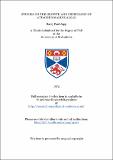Files in this item
Studies on the growth and physiology of attached marine algae
Item metadata
| dc.contributor.advisor | Drew, E. A. | |
| dc.contributor.author | Jupp, Barry Paul | |
| dc.coverage.spatial | 238 p. | en_US |
| dc.date.accessioned | 2018-06-19T15:36:10Z | |
| dc.date.available | 2018-06-19T15:36:10Z | |
| dc.date.issued | 1972 | |
| dc.identifier.uri | https://hdl.handle.net/10023/14281 | |
| dc.description.abstract | 1. The net annual primary productivity of L, hyperborea has been estimated from biomass increment croppings and biomass: age relationships, The values of 16.5 mt organic matter/ha/year at 3.lm and 8,Omt organic matter/ha/year at 9.1m indicate., the high productivity of this species, 2. Various other growth parameters such as maximum biomass, LAI, net assimilation rate, chlorophyll content and index, and photosynthetic rates have been compared with the data for other communities. 3. An 'in situ' technique, which seems to measure a value close to gross photosynthesis in L, hyperborea, has been used to estimate the photosynthetic capacity of tissues of L. hyperborea at various depths, under the forest canopy, and during the seasonal growth with the following conclusions:- a) Photosynthetic efficiency was found to increase with depth b) The forest canopy had a marked shading effect on the photosynthetic capacity of tissue sections, c) Photosynthesis measured during the season showed that growing lamina tissue was below the compensation point in February, that maximum photosynthesis was in May, and that photosynthesis decreased in the summer. d) The values for daily net photosynthesis compared favourably with estimates of net assimilation rate from biomass studies, 4, Laboratory investigations on photosynthesis gave the following saturation and compensation data:- The new lamina of shallow plants was found to have a higher photosynthetic efficiency than the old lamj.na of shallow plants at low irradiance. The old lamina was found to have a slightly higher photo synthetic efficiency at low irradiance than the lamina of deep growing plants. 5. Respiration rates were measured at various temperatures and the stenothermal nature of the lamina tissue was shown in the RT curve, Lamina tissue was found to have a low optimum temperature for respiration of 9.5°C, The respiration rate of deep-growing plants appeared to be lower than shallow plants. Mannitol was implicated as the primary respiratory substrate and was interconvertible with laminarin; the latter did not appear to be utilised as suggested by Yamaguchi et al. (1966). There appeared to be little heterotrophic uptake and utilisation of exogenously supplied glucose but differences in uptake rates found were found between tissues, that of the stipe and holdfast being greater than the lamina, 6. Young sporophytes maintained in culture showed that low irradiance resulted in a thinner lamina than that found in high light grown plants and light was implicated as an additional factor to wave action in the control of lamina morphology 'in situ'. Deep-growing plants which also had a thinner lamina than shallow plants, had an increased chlorophyll content on a weight basis but not on lamina area basis compared with shallow plants. The increased chlorophyll content was not accommodated by changes in the internal ultrastructure of the chloroplasts, 7. Evidence was presented for a translocation of C14 labelled assimilates from the old lamina to the new lamina and stipe and from the stipe to the lamina. The rate of movement varied from 1.5 to 9cm/h. The mass transfer varied from 0.1.mg mannitol/day from the lamina to the stipe and from 13mg mannitol/day from the stipe to the new lamina, and from 2 to 6mg mannitol/day from the old lamina to the new lamina. These amounts were considered to be capable of supporting observed growth rates of the new lamina from biometric data. | en_US |
| dc.language.iso | en | en_US |
| dc.publisher | University of St Andrews | |
| dc.subject.lcc | QK745.J8 | en |
| dc.subject.lcsh | Growth regulators | en |
| dc.title | Studies on the growth and physiology of attached marine algae | en_US |
| dc.type | Thesis | en_US |
| dc.contributor.sponsor | Natural Environment Research Council (NERC) | en_US |
| dc.type.qualificationlevel | Doctoral | en_US |
| dc.type.qualificationname | PhD Doctor of Philosophy | en_US |
| dc.publisher.institution | The University of St Andrews | en_US |
This item appears in the following Collection(s)
Items in the St Andrews Research Repository are protected by copyright, with all rights reserved, unless otherwise indicated.

